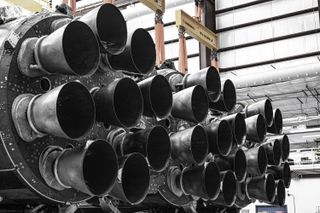
The most powerful rocket in the world is getting ready to take flight for the first time in more than three years.
SpaceX has linked up the three boosters that comprise the first stage of its Falcon Heavy rocket, in preparation for an upcoming liftoff from Pad 39A at NASA's Kennedy Space Center.
SpaceX posted a photo of that milestone on Twitter Sunday (Oct. 23), showing the three boosters laid out horizontally, their combined 27 Merlin engines all visible.
"Falcon Heavy in the hangar at Launch Complex 39A," the company tweeted as a caption to the photo.
Related: NASA picks SpaceX's Falcon Heavy rocket to launch Roman Space Telescope
Those three boosters are modified first stages of the Falcon 9, SpaceX's workhorse rocket. The Falcon Heavy straps them together and puts a payload-carrying second stage atop the central booster.
Together, those 27 Merlin engines generate about 5 million pounds of thrust at liftoff, which is unmatched among rockets flying today.
Get the Space.com Newsletter
Breaking space news, the latest updates on rocket launches, skywatching events and more!
"Falcon Heavy is the most powerful operational rocket in the world by a factor of two," SpaceX's Falcon Heavy specifications page reads. "With the ability to lift into orbit nearly 64 metric tons (141,000 lb), Falcon Heavy can lift more than twice the payload of the next closest operational vehicle, the [United Launch Alliance] Delta IV Heavy."
The current Falcon Heavy work at Pad 39A supports USSF-44, a coming mission that will launch two classified satellites to distant geostationary orbit for the U.S. Space Force. The launch date has not yet been officially announced, though various sources identify a "no earlier than" date of Oct. 31.
Falcon Heavy first stages, like those of the Falcon 9, are designed to be reusable. But only two of the three boosters on USSF-44 will come back to Earth for safe touchdowns; the central core will be ditched, falling into the sea when its launch work is done.
USSF-44 will be the first Falcon Heavy launch since June 2019 and just the fourth overall for the burly rocket. Its debut in February 2018 was one of the most memorable launches in recent memory: The test flight sent Elon Musk's Tesla roadster, "driven" by a spacesuit-clad mannequin named Starman, into orbit around the sun.
Mike Wall is the author of "Out There" (Grand Central Publishing, 2018; illustrated by Karl Tate), a book about the search for alien life. Follow him on Twitter @michaeldwall. Follow us on Twitter @Spacedotcom or on Facebook.
Join our Space Forums to keep talking space on the latest missions, night sky and more! And if you have a news tip, correction or comment, let us know at: community@space.com.

Michael Wall is a Senior Space Writer with Space.com and joined the team in 2010. He primarily covers exoplanets, spaceflight and military space, but has been known to dabble in the space art beat. His book about the search for alien life, "Out There," was published on Nov. 13, 2018. Before becoming a science writer, Michael worked as a herpetologist and wildlife biologist. He has a Ph.D. in evolutionary biology from the University of Sydney, Australia, a bachelor's degree from the University of Arizona, and a graduate certificate in science writing from the University of California, Santa Cruz. To find out what his latest project is, you can follow Michael on Twitter.
